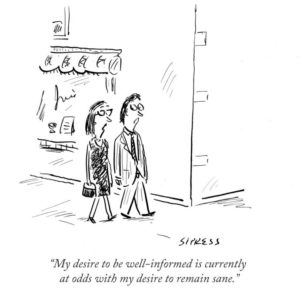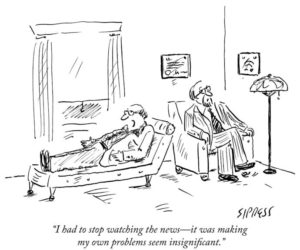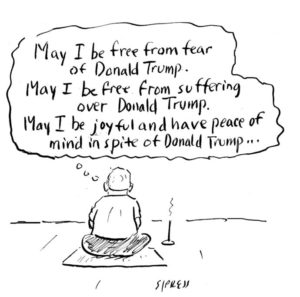Editor’s note: the following text by classmate David Sipress originally appeared in the online version of the New Yorker. It’s reproduced here with his permission. Warning: cartoons ahead.
Of all my cartoons, the one above is the most published, republished, tweeted, retweeted, liked, shared, or stolen and reprinted without my permission. Just this week, the cartoon was featured in a Times article about coping with the relentless and unsettling news environment that we’re living in these days.
“Well-informed” never appeared in The New Yorker. In fact, I’m not sure where it was first published. It dates from the Clinton Administration, and I have no memory of what event or series of events inspired it. But, every time the news gets particularly dire, the cartoon pops up all over the place. Its appearances on social media have spiked during the past year, and never more so than in the aftermath of National Patriotic Devotion Day—a.k.a. the Inauguration of Donald Trump.
A therapist friend recently reported that his clients are talking more about the news and its impact on their mental health than they are about any of the issues they’ve been working on for years. This brought to mind another cartoon of mine, this one, from 2014:
My own mental health has definitely taken a hit. From late last summer through early December, I drew a topical cartoon (the Daily Cartoon) five days a week for newyorker.com. I was forced to stay extremely well-informed in order to make jokes about the very stuff that was turning my head into a dark, scary place, and wreaking havoc on my digestive system. (It’s my habit to read or watch news during meals.) At night, I lay in bed, sleepless for hours, replaying the day’s events.
The Daily Cartoon gig ended on December 6th, freeing me up to take a total break from the news. This respite extended into early January, when my wife and I left for a welcome vacation in a faraway land. For two weeks, I filled my head with great art and my stomach with amazing food, and successfully pretended that Trumpland had ceased to exist. I slept like a baby.
Waiting to board our flight home, my dream of escape abruptly ended. A father and teen-age son stood just within earshot, in the Business First line. The boy was challenging his father’s Trump vote, citing examples of bigotry, instability, and ignorance.
“Listen,” the father said, “that’s probably all true. But grow up. If voting for Trump is good for me, then Trump gets my vote. Period. End of story.”
If voting for Trump is good for me, then Trump gets my vote.
I looked at my wife. “I don’t believe it,” I said.
“Believe it,” she replied.
We got home the evening of January 19th. The next morning, as my wife got ready to leave for the Women’s March in Washington, D.C., I warily waded back into the fray, perusing the Times. Soon after Trump wrapped up his “America First” speech, I was deep into my old online routine—cycling with increasing frequency through the Times, the Washington Post, the Huffington Post, CNN, MSNBC, BBC, Politico, Slate, even Fox.
That afternoon, I started making a list of highlights, and I’ve continued to add to it ever since. Samples include “Reviving the pipelines”; “Likes black sites and torture”; “Going to build the wall”; “Trade war”; “Alternative facts”; “Millions to lose insurance”; “Defund Planned Parenthood”; “DeVos—enemy of public ed”; “Price—no guarantee for Medicare and Medicaid”; “Racist Bannon to be on N.S.C.”; “Airport worker in hijab attacked”; “Immigration ban”; “The nuclear option”; “Frederick Douglass has done an amazing job.”
I thought that writing down the worst things could perhaps diminish their power to mess with my mental health. The opposite has happened. The sheer length and psychic weight of the list is deeply dispiriting. And then there’s the variety—the fact that so many different bad things can happen all at once. I’m left dazed and confused—muddled about the best target for my outrage. Even understanding that sowing confusion and chaos with this scattershot approach is a conscious Trump strategy doesn’t help to clear the head.
I’ve also been making a list of good stories. Needless to say, it’s short: “The women’s marches”; “Federal judges oppose travel ban”; “McCain speaks out”; “Taxi drivers strike at J.F.K.”; “Acting A.G. refuses to enforce the ban”; “Dems vow to fight.” The list includes some wishful thinking (“WikiLeaks may get tax returns”) and at least one future fantasy (“Trump pal Tom Brady humiliated in devastating Super bowl loss”).
Ironically, it’s a “good” story that has caused me the most angst: “Dow reaches 20,000.” After seeing this headline on CNN, last week, I checked my meagre stock portfolio. I generally avoid doing this for months at a time, to keep fears about the future at bay. When I discovered that I’ve been doing very nicely indeed since November 9th, the momentary surge of comfort and warm satisfaction I experienced nearly undid me, leaving me with a feeling of shame that I can’t quite shake. Did I really have something in common with the father in the Business First line? I immediately sent a donation to the A.C.L.U.
In my effort to “remain sane,” I’ve begun to speak with my wife and my friends about how they are coping. Everyone is feeling overwhelmed and agrees that it’s crucial to ration your intake of news. We have a new rule in our house to help with sleep problems—no news after 7 p.m. It was originally 8 p.m., but I was unable to resist “Hardball,” and, as I learned, Chris Matthews tends to get me more agitated than the pundits I hate.
Everyone I’ve talked to is frightened. Everyone feels helpless and depressed. And all agree that the best way to stop feeling those things is to do something. “Doing something,” my wife tells me, “does not mean liking other people’s Facebook posts and retweeting like-minded points of view.” She and my friends talk about writing their member of Congress and joining demonstrations like the ones protesting the immigration ban. And everyone has emphasized self-care, whatever form that takes—exercise, yoga, therapy, just making sure to have fun now and then. In the words of one friend, “I plan to take care of myself and stay healthy and not go crazy over every story so that I can be calm and strong enough to resist.”
Easier said than done, but I’m giving it all a try. Joining the Women’s March in New York City raised my spirits enormously. So I’ll attend every demonstration I can. I will send postcards, make calls, sign petitions, and—who knows?—maybe get arrested. But, most important, I’ll continue to employ my personal self-care remedy for news-induced psychosis: drawing cartoons—cartoons about what’s going on out in the world and what’s going on in here, in my head.
And I’ve even begun practicing meditation:



